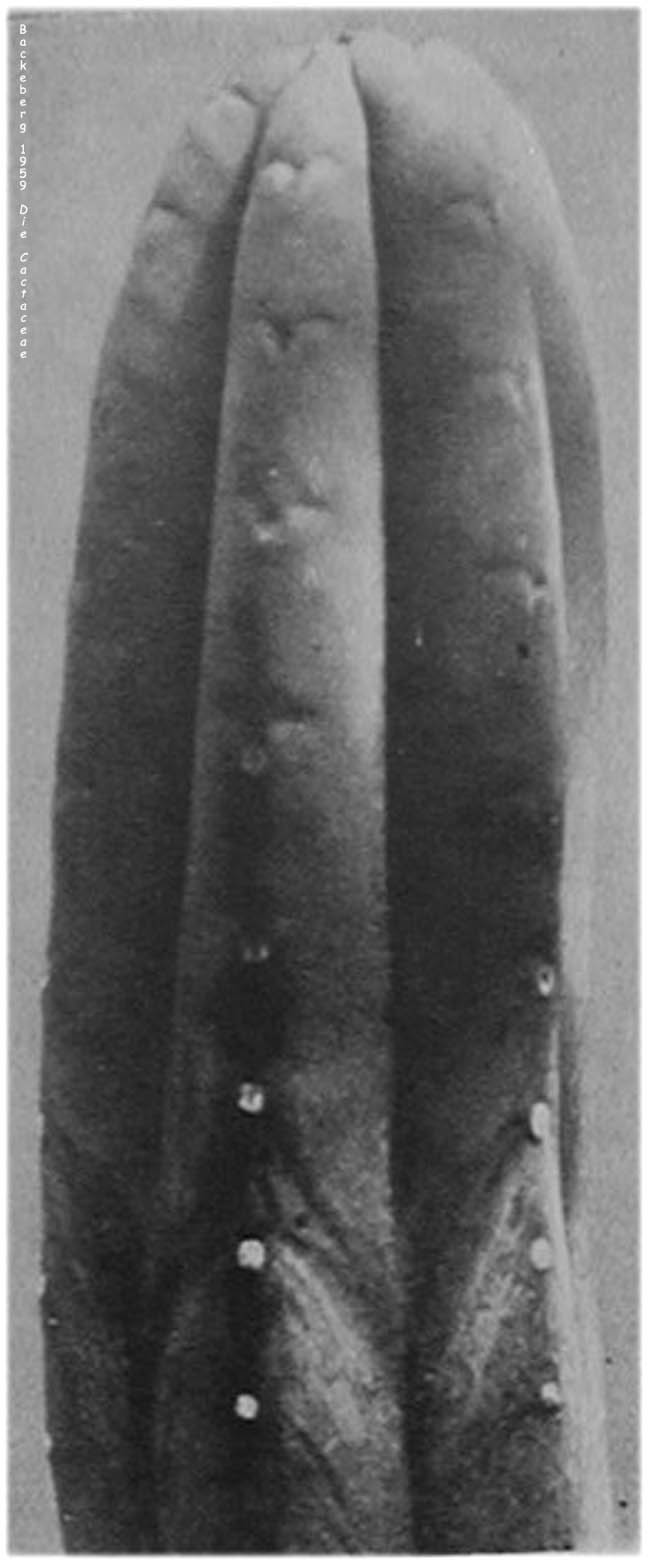The pentagona name game
How many of the species for these “pentagona“s can you identify without looking at the answers that are located at the bottom of the page?
"More than YOU want to know?
There are abundant Trichocereus pachanoi in the adjacent countryside.
Typically they are growing amidst the cover of nurse plants, this sometimes is including stands of Anadenanthera trees. Alana Cory-Collins has commented on there being a historical succession from snuff to cactus for the Chavín in Peru but was unclear where their Anadenanthera had come from only that it obviously came to them as a trade item.
Smith’s observations
with excerpts from some published descriptions.
Topic 1: Backeberg’s clone
Topic 2: pachanoi compared to pachanot.
Additional material to ponder:
Copyright © by Keeper Trout

Assuming there really is such a thing as “Backeberg’s clone” it will look like the tip above and not like the pachanot.
If anyone knows anything about the material Backeberg said he brought into horticulture I would love hearing about it. Drop me an email or snail mail.
Smith’s observations
with excerpts from some published descriptions.
Topic 1: Backeberg’s clone
Topic 2: pachanoi compared to pachanot.
Additional material to ponder:
Some of the assorted horticultural pachanoi presently in Germany are shown in the following images. In many, perhaps most cases, the origin information for the assorted forms and collections of Trichocereus pachanoi forms that are present in Europe is not known.
Many more Trichocereus images from Europe and elsewhere can be found at http://trichocereus.net.
The first image is of a cultivar originally collected in Peru by a German collector named Kaiserwerth. This is sold under the name Trichocereus peruvianus
This was obtained from a cactus vendor in Spain.
Some other pachanoi present in German horticulture; these are are lacking further information.
This is thusfar the oldest representative of a cactus line sold commercially as a pachanoi that Evil Genius can locate in Germany.
He has some questions concerning its identity and is working on learning more information.
All images are copyright © by Evil Genius; Reproduced with permission by Trout’s Notes
Smith’s observations
with excerpts from some published descriptions.
Topic 1: Backeberg’s clone
Topic 2: pachanoi compared to pachanot.
Additional material to ponder:
Copyright © by Keeper Trout
Copyright © as indicated
Smith’s observations
with excerpts from some published descriptions.
Topic 1: Backeberg’s clone
Topic 2: pachanoi compared to pachanot.
Additional material to ponder:
Areoles of “our pachanot” (top) and Trichocereus pachanoi (bottom) compared.
While it would be possible to assemble a whole page comparing their areoles, I suspect that enough already exist elsewhere in this article, so only a simple pair is being included below.
Our pachanot above
Trichocereus pachanoi below
Copyright © by Keeper Trout (top) and by Evil Genius (lower)
A comparison of the flowers from a few assorted Trichocereus species that appear to be closely related to each other based on their simple morphology. (click to return to the smaller views):
Copyright © by Keeper Trout
There are many forms of Trichocereus bridgesii (aka Echinopsis lageniformis) in the wild and represented in horticulture. The images below represent just a few of those many.
Anderson appears to have expanded the range of Trichocereus bridgesii well into Peru and applied it to the Trichocereus huanucoensis at Huanuco which can reach 7 (or more) inches in diameter. This was done with no inclusion of any additional details so we can only wonder at Anderson’s reasoning as to why he felt it was closer to Trichocereus bridgesii than Trichocereus pachanoi or Trichocereus peruvianus.
Cuttings on the top left came from Huanuco, Peru.
Photograph is copyright by Kitzu.
I was told that its spines fell off during transportation.
Image above on the right & the next pair below are H 1294 at the Huntington.
These were obtained as 8 seedlings from Curt Backeberg, which they received the 9th of February 1932.
Both tips of the next tips are of aff. bridgesii (H 79960 at the Huntington)
A Trichocereus bridgesii grown from Friedrich Ritter’s seeds that were obtained by UC in 1953.
Although most of these are in cultivation everything depicted above is originally from wild collections.
Some views of Trichocereus bridgesii in Bolivia.
Next are offerings from two different witches markets in Bolivia that appear to be for tourists.
While some of the tips shown are thus far the closest cacti we have yet seen to the pachanot, this is misleading as they also typically to show the presence of some much longer spines which on these cuttings have been removed.
A couple of oddly stout Trichocereus bridgesii in horticulture. The one on the right was purchased as Trichocereus pachanoi in New Mexico.
Copyright © by Keeper Trout
except where indicated otherwise.
One of at least several forms expressed by seedlings of the purported Trichocereus peruvianus huancabamba is shown below. This one was grown by Oasis from seeds that Kermit had obtained from Mesa Garden.
Under some conditions of growth the pachanot can look rather similar.
Copyright © by Keeper Trout
A comparison of the flowers from a few assorted Trichocereus species that appear to be closely related to each other based on their simple morphology. (click here for a larger version):
Copyright © by Keeper Trout
